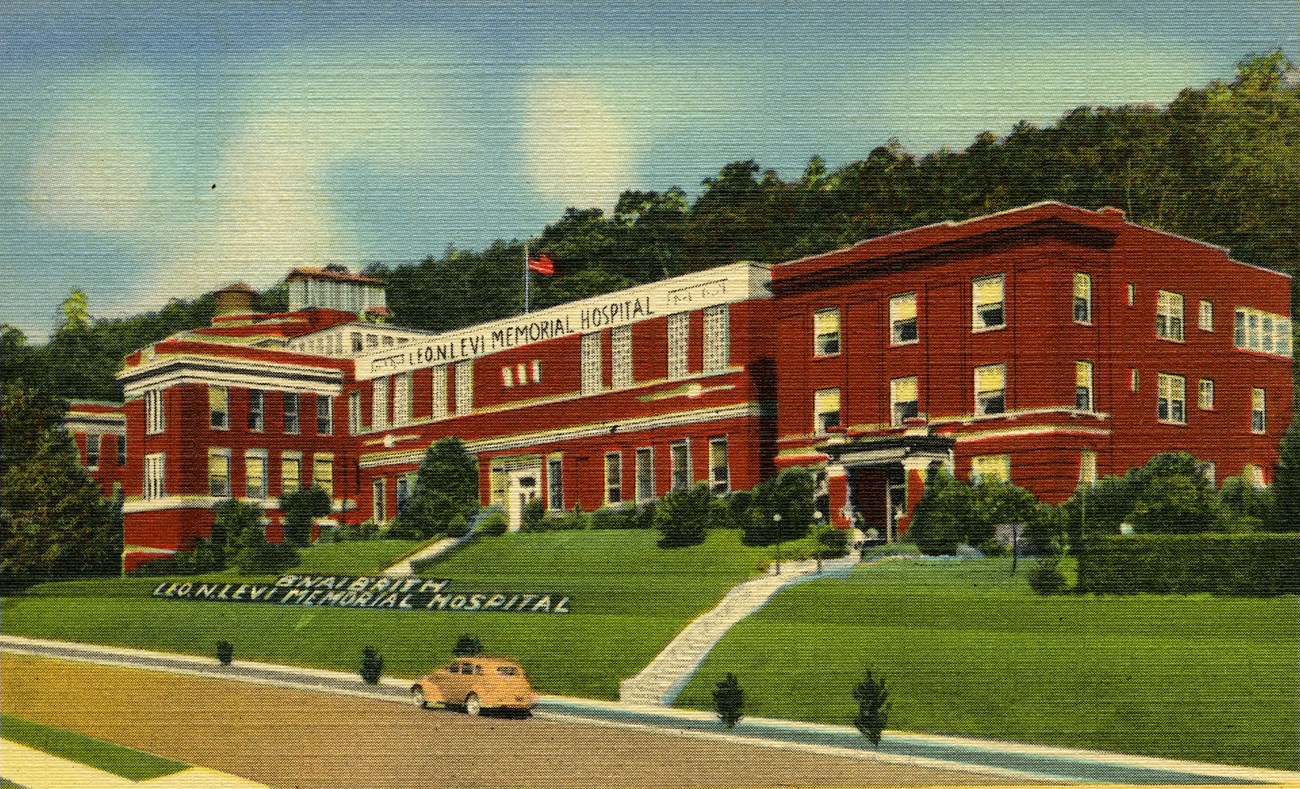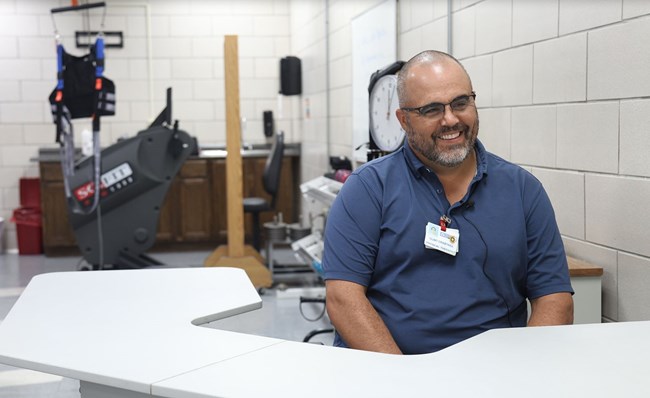Last updated: June 25, 2024
Article
A Partnership Built on Faith and Water: The Levi Memorial Hospital and Hot Springs National Park

Hot Springs National Park Archives
In 1902, B’nai B’rith District Grand Lodge No. 7 held their annual convention in Little Rock, Arkansas. Grand Lodge No. 7 represented just one of many regional hubs for B’nai B’rith, then the oldest and largest Jewish philanthropic institution in the United States. Convention participants at Grand Lodge No. 7 encouraged the group to turn their attention to Hot Springs, Arkansas. “This city is a veritable mecca for a large number of poor Jews who seek health,” and that a new hospital in Hot Springs was “a crying necessity.”[1] After a decade of advocacy, B’nai B’rith, with the cooperation of Hot Springs Reservation (later Hot Springs National Park), completed construction of the Leo N. Levi Memorial Hospital. The charitable hospital opened in 1914 and remains open today.

Hot Springs National Park Archives.
"A National Jewish Sanitarium"
Jewish people visted the area from the earliest days of Hot Springs Reservation. Jacob Mitchell and his wife, Jews arriving from Van Buren, Arkansas, constructed a hotel to house the thousands of visitors coming to take the waters for their health.[2] Proprietors in hotels and restaurants served kosher meals and catered to Jewish tourists.[3]Rabbi Abraham Benedict Rhine of Hot Springs chronicled how the influx of Jewish visitors strained the few Jewish resources in town: “The Jewish community of Hot Springs… cherished the hope that the time would come when a national Jewish Sanitarium would be established in Hot Springs for the treatment of the sick poor who flocked there in search of health.” Rhine noted how his local network “was too small for such an undertaking.”[4] He and others sought the help of B’nai B’rith to make their hopes a reality.
With the active support of Rabbi Rhine and Rabbi F. L. Rosenthal, B’nai B’rith created the Leo N. Levi Memorial Hospital Association in 1911, consolidating funds and resources to build a hospital. The Department of the Interior allotted a small section of the government reservation for the construction of the hospital at the base of West Mountain. Jewish architect Eugene Stern from Little Rock, Arkansas, whose firm designed other famous bathhouses in Hot Springs, submitted drawings to the federal government detailing a state-of-the-art hospital. Work began in March 1913 and the hospital opened on November 1, 1914. Hot Springs Reservation Superintendent Dr. William P. Parks described the completed hospital as “modern in every detail” in 1915, noting that it offered 1,670 baths in its first year.[5]

Hot Springs National Park Archives
"Restored to Health and Strength"
Hot Springs National Park’s thermal waters were vital to the success of the Levi. “The hospital was erected in Hot Springs because of the therapeutic value of the waters,” declared Regina Kaplan in 1922.[6] She served as superintendent of the Levi for more than 30 years. The hospital’s hydrotherapy department boasted two bath halls, vapor baths, pack rooms, and cooling rooms. These treatments rivaled many of those in the elegant establishments on the world-famous Bathhouse Row. Information about the hospital appeared in Jewish publications across the Midwest, spurring more visitors to Hot Springs and patients to the Levi. The hospital continued to grow in popularity, admitting its one thousandth patient in January 1920 and roughly 1,500 patients in 1924 at a charitable expenditure of nearly $45,000 every year.[7]B’nai B’rith viewed a charity hospital in Hot Springs as part of its larger philanthropic health mission across the United States. In 1916, B’nai B’rith appropriated $80,000 to Levi Memorial Hospital, along with its National Jewish Hospital for Consumptives in Denver, Colorado, and an orphanage in Cleveland, Ohio. In his presidential address that year, Dr. Haim I. Davis said that “all our hopes have been fully realized” at the Levi. “The institution is a boon to mankind.”[8]
While the hospital was conceived to alleviate the burden upon Hot Springs’ Jewish community, it opened its doors to all, whether Jewish or not. Its funding sources also diversified, extending to local and regional groups around the state. Even as a non-sectarian institution, Levi Memorial Hospital introduced many non-Jewish visitors to Jewish culture. Rabbi Rhine concluded, “It was in the Hospital that many of those non-Jewish patients first came in contact with Jews and Jewish Philanthropy.”[9] Physicians at the Levi often took in thousands of patients who needed prescriptions to bathe at the Government Free Bathhouse in the national park. In this way, Jewish leaders sought to counter the anti-Semitism prevalent in the United States.
In 1920, the hospital provided 5,068 baths. By 1938, as Americans from across the country reeled from the repercussions of the Great Depression, that number nearly tripled to 14,586 baths. “Statistics are usually lifeless figures;” wrote Rabbi Rhine in a 1939 article celebrating the twenty-fifth anniversary of the institution, “in the case of the Hospital, however, they assume tremendous significance.” The statistics represented patients, men, women and children who left the hospital “restored to health and strength; revived, reinvigorated with the buoyancy of youth and health and hope.”[10]
One of those patients was Jerry Marx Bernstein, who came to Hot Springs, Arkansas, in 1935 “crippled to nearly total paralysis.” He, like thousands before him and thousands more to follow, put his faith in the “most advanced methods of physical therapy and the newest medical discoveries” at the Levi Memorial Hospital. Bernstein slowly improved, beginning a career in radio and “A RETURN TO THE LAND OF THE LIVING!” When asked what he attributed his recovery to, he responded: “The biggest part of the answer lies back on the slopes of West Mountain in Hot Springs, Arkansas, in a sprawling red brick building that somehow has a heart and a soul… an institution that gives hope to the hopeless and restores health, not only to the body but also to the mind.”[11]

Hot Springs National Park Archives.
"It's a Great Partnership"
Supporters of the hospital reoriented the institution’s significance in the 1940s as the United States entered World War II in 1941. Jewish publications highlighted the work at the Levi that kept the country ready to fight. Martin Perley, a correspondent for the Wisconsin Jewish Chronicle, described arthritis and rheumatism as domestic saboteurs in the war effort, causing a loss of 97,200,000 work days each year on the home front. “Nationwide campaigns are being conducted to salvage scrap metal and other materials to keep the wheels of our war industry moving,” wrote Perley. The Levi “is doing its share in salvaging human man power from the ravages of pain and despair, fitting them for the vital task of keeping our war machine going.”[12]A specific example involved Private John Golik from Milwaukee, Wisconsin, who wanted to serve but was paralyzed with arthritis. His local Jewish community arranged for him to visit the Levi in 1942. The hospital, according to the Jewish Morning Call in Patterson, New Jersey, performed a “minor miracle,” transforming the private “into a healthy soldier in Uncle Sam’s Army.” Golik returned to service after his stay at the hospital, saying, “I am a Gentile and wish to say here that I spent two months in a Jewish hospital and was treated like one of a big family.”[13]
Patients and promoters continued their endorsements of the thermal waters at Levi throughout the twentieth century. “The pain-easing thermal waters of Hot Springs, Arkansas, are a major factor in arthritic therapy at Leo N. Levi,” concluded a correspondent from the Jewish Press in Omaha, Nebraska. “Patients enjoy the double benefit of the soothing qualities of the water and scientifically planned exercises to assist in restoring stiffened joints and atrophied muscles,” all taking place in one of the largest thermal water pools in all of Hot Springs.[14] After the war, the National Arthritis Research Foundation stationed its headquarters at the Levi Memorial Hospital, putting it and the national park’s thermal waters at the center of national arthritis research for decades.
Present-day staff at the hospital also recognize the connection between this past pillar of the Jewish community in Hot Springs and the national park. The hospital has adjusted to the needs of its community by primarily offering mental and physical therapy. It still uses the national park’s thermal water in its treatment. “It’s a great partnership,” concluded Clint Crabtree, current Director of Rehabilitation Services at the Levi when describing the century-long connection between the hospital and park. The Levi turns the park’s thermal water into a “tool,” according to Crabtree, that improves mobility for patients. The hospital also brings the waters to patients with mobility issues.[15] Records show the hospital uses more than two million gallons of thermal water every year in rehabilitation efforts for patients and the community.
The relationship between Levi Memorial Hospital and Hot Springs National Park demonstrates an enduring connection between Jewish American communities and the National Park Service that is older than the Service itself. The hospital represents successful Jewish philanthropic work and the vibrancy of Jewish history in Hot Springs. Levi Memorial Hospital became “one of the great American Jewish philanthropic institutions,” using the national park’s thermal water to treat disabled Jewish visitors to Hot Springs, combating anti-Semitism through caring for all those who needed help, and providing a lasting site of thermal water medicinal care in Hot Springs, Arkansas.[16]
Endnotes
1. Carolyn Gray LeMaster, A Corner of the Tapestry: A History of the Jewish Experience in Arkansas 1820s – 1990s (Fayetteville: University of Arkansas Press, 1994), 70.
2. Ibid., 11-12.
3. “Encyclopedia of Southern Jewish Communities – Hot Springs, Arkansas,” Goldring/Woldenberg Institute of Southern Jewish Life, accessed September 19, 2023, https://www.isjl.org/arkansas-hot-springs-encyclopedia.html
4. A.B. Rhine, “The History of the Leo N. Levi Memorial Hospital,” The Jewish Voice, 31 October 1913, 8.
5. William P. Parks, Report of the Superintendent of the Hot Springs Reservation (Washington, D.C.: Government Printing Office, August 13, 1915), 1139.
6. Regina Kaplan, “Leo N. Levi Hospital at Hot Springs National Institution,” Arkansas Democrat, 9 April 1922, 29.
7. Dale E. Wagoner, Levi Arthritis Hospital: More Lasting Than Marble Or Stone, 9, available at Levi Memorial Hospital; “13th Annual Report of the Leo N. Levi Memorial Hospital,” Wisconsin Jewish Chronicle, 2 May 1924, 5.
8. Dr. Haim I. Davis, “President’s Message,” Proceedings of the Forty-Eighth Annual Convention of District Grand Lodge No. 6 I. O. B. B., 23.
9. A. B. Rhine, “The Leo N. Levi Memorial Hospital,” B’nai B’rith Magazine XLI No. 9 (June, 1927), 386.
10. A. B. Rhine, “Leon Levi Hospital Celebrates Its Twenty-fifth Anniversary,” The Modern View, 9 March 1939, 3.
11. Jerry Marx Bernstein, “The Long Road Back,” Southwest Jewish Chronicle, 1 June 1955, 8-9.
12. Martin M. Perley, “Disease Sabotages Home Front,” Wisconsin Jewish Chronicle, 18 December 1942, 8.
13. “Jewish Hospital Worked ‘Miracle’ For Cripple,” The Morning Call, 13 March 1942, 6.
14. “Leo Levi Hospital Built on Hope and Faith,” The Jewish Press (Omaha, NE), 12 September 1947, 29.
15. Clint Crabtree; Daniel Chmill; 5 September 2023, Levi Memorial Hospital; video recording; Hot Springs National Park Archives, Hot Springs, Arkansas.
16. “Season’s Greetings from the Leo N. Levi Memorial Hospital,” The Modern View (St. Louis, MO), 2 September 1937, 84.
